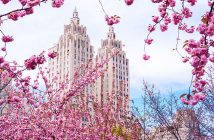
Jo Anna Isaak, Ph.D., is charting the trajectory of environmental engagement in modernist art.
Photo by Nina Romeo
While many people may not know the name Robert Smithson, they are probably familiar with his most famous work of art, Spiral Jetty (1970), a 1,500-foot coil of sand, basalt rocks and precipitated salt crystals that curls into Utah’s Great Salt Lake.
Spiral Jetty was created through a massive altering andrearranging of natural elements, but as noted by Jo Anna Isaak, Ph.D., professor and chair in the Department of Art History, it has played an important role in protecting that same natural environment.
When plans were announced for exploratory oil drilling to commence within five miles of Smithson’s earthwork sculpture, the forceful protest that arose contributed to the state’s denial of the drilling application. Not only did the protesters want to protect the artwork, but also the remote, fragile landscape that the Spiral Jetty helped to make people aware of.
Isaak, the John L. Marion Chair in Art History, believes it is natural for art to play this type of role in environmental activism. A main goal of her work as an art historian is to promote the idea that art serves a vital and necessary social purpose.
This conviction has led to one of her current projects, The Greening of the Avant-Garde, a forthcoming book that revises established views about the social detachment of the modernist movement in art.
“The whole idea of art for art’s sake, which is so central to modernism, is a kind of abdication of social responsibility on one level,” Isaak said. “It might have sounded liberating at some point in time, but it meant that art became removed from the practice of real life. I don’t believe that was the agenda of modernism.”
For Isaak, an environmental social commitment resided within modernism from its inception, and her aim in Greening is to trace its trajectory in its European and American manifestations.
Isaak’s historical narrative in Europe begins with the Impressionist painters, who are commonly associated with a type of idyllic placidness like that depicted in Georges Seurat’s Sunday Afternoon on the Island of La Grande Jatte (1884-1886). But Isaak is quick to point out that the full story of the Impressionists is more complex.
“Impressionist painters often documented environmental degradation, what industrialization was doing to the laborers in the factories and to their health, what it meant to move off the farms and work in masses.”
Isaak sees examples of this social engagement in the paintings of Pissarro, Degas and Seurat, many of which show the encroachment of industrialization into the countryside, where factories send streams of black smoke into the blue, cloud-strewn sky.
In America, Isaak finds that artists took a different approach to environmental preservation, based on the idea that the country had an abounding wilderness, something Europeans could no longer claim.
For Isaak, an environmental project is evident in the 19th-century landscape paintings of Thomas Cole and the 20th-century photographs of Ansel Adams, both of whom celebrated the vast American wilderness. At the same time there was growing consciousness of the fact that they were simultaneously recording the loss of that very wilderness.
Adams in particular, as a primary photographer for the Sierra Club, had an explicit conservationist purpose driving his photographic endeavors.
“Adams created an image of pristine, untouched, perfect America that—even if it wasn’t true, and it’s not—it made people want to preserve it,” Isaak said.
With the research and writing of Greening still in progress, Isaak has been asked by Phaidon Press to write a book surveying the career of Louise Bourgeois for its Basic Artists Series.
Bourgeois, who died in 2010, lived to be nearly 100 years old. “Her life time spanned modern and contemporary art,” Isaak said. But beyond her own era, Bourgeois absorbed and re-processed an enormous range of artistic history.
Isaak called Bourgeois the “James Joyce of modern art” in that she, like Joyce, shared an historical consciousness which led them to mine the cultural manifestations of the past. Both were encyclopedic collectors and recyclers of history and culture on a vast scale. In Bourgeois’ artwork and sculptures, Isaak found, for example, references to Paleolithic wall paintings; Cycladic, Etruscan, Mycenaean Greek, Roman and African art; the cave paintings at Lascaux; the Egyptian Sphinxes; and the statues of Artemis found at Ephesus, all brought into her own artistic and intellectual discourse.
Isaak interprets Bourgeois’ practice, however, as more than a form of postmodern appropriation or borrowing.
“Postmodernist appropriation has to do with distance and irony, a kind of Oedipal rivalry with the past art,” she said. “In Bourgeois’ art, the past has been nurtured in some deep way, made and molded so that it is made to participate in the contemporary cultural process. Bourgeois is a kind of cultural mid-wife; her process is maieutic. When we look at it, we recognize a vast cultural ancestry, as if the past had been moving towards this formation which in turn will lead to another. She is a sort of progenitor of past culture and she brings it to life in the present.”
Isaak’s research on Bourgeois aligns with her preparation fora course on modernism in art and literature, which she will teach this fall, and it also builds upon the work of her two previous books:Feminism and Contemporary Art: The Revolutionary Power of Women’s Laughter (Routledge, 1997) and The Ruin of Representation in Modernist Art and Texts (UMI Research Press, 1986).


